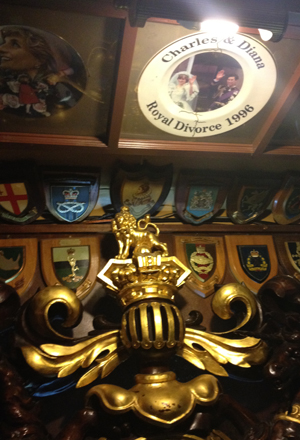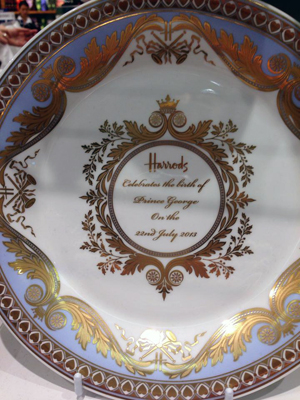Stone birds perch atop the Two Eagles House in South London. They have long curved necks like vultures, but presumably they are eagles. From way down at street level, it is hard to tell. And in any case, there are four of them.
Twenty-three years ago I lived and worked here, pulling blue-collar pints for room and board while working at another pub over in Piccadilly to earn travel money for a trip across the Continent. Not long after I left, the Two Eagles closed down and the building was sold for flats. I knew this, but I wanted to visit anyway. So last week I took the Bakerloo Line to its dungeon terminus at Elephant and Castle, and walked back toward my old home on 27 Austral Street.
Just one block shy, I worried that perhaps I was lost. That I might have misremembered the way to 27 Austral Street. So I stopped into a corner store to ask the clerk if he knew where the old Two Eagles was. He was a young immigrant and had never even heard of a place called the Two Eagles. I continued to the end of the block and came upon the familiar building rising up in the late Sunday darkness. Complete with “Two Eagles House” in large lettering. The clerk will never know what he missed.
I stood outside the old building for a while, trying to photograph it in the dark. Trying not to attract undue attention from the neighbors. There was a light was on in my old bedroom on the top floor, but the building was mostly vacant, with flats still available. Hanging in a window next door, a bright poster celebrated Eid, the end of Ramadan. Not likely pub patrons, I thought.
One block onward I came to an open pub, but they didn’t have traditional English ales and the few people inside were far too young to remember the Two Eagles. So I moved on to the Three Stags, where the bartender allowed me one post-closing-bell pint of ale. It was a chance to sit and meditate about the Two Eagles and its long-gone patrons and my lost youth. Crap like that.
It occurred to me that this bartender with his two-foot dreadlocks was about the same age I had been when as a young college student, I worked in the same neighborhood, pulling pints of bitter so that I could see Europe. Maybe he was doing the that too. Nostalgia. “I used to work in pub just around the corner there,” I offered. “The Two Eagles.” He stopped cleaning long enough to answer: “The two what?”
So the bartender at the Three Stags and the young people in the pub nearby and the clerk at the store a block from Austral Street and the neighbor celebrating Eid not ten steps from where a pubic house operated between 1809 and the early 1990s, they do not remember the Two Eagles.
But I do. And this is a little of what they missed:
The Proprietor, who confused me when offering me a job by calling himself Joanne. I later realized that he and his wife were Joe and Ann. He believed that it was bad luck for two people to be on the same flight of stairs at the same time, which in a four-story building will cause an occasional traffic jam.
The Proprietress, Ann, who lovingly created the sturdiest of English meals as my board for nearly four months without once changing the oil in the deep fryer. Her son suffered from cystic fibrosis. Her daughter taught me to watch a regular patron whose abdominal hernia grew visibly throughout each night of drinking.
Barry, the master cellarman, who told me matter-of-factly that dogs don’t trust black people: “It’s like they know something.” His assistant, who was my age, believed that the BBC was trying to cover up the truth about spontaneous combustion. Some people just erupt in flames.
The Friend of Ned, whose name I cannot remember, but who I do remember was especially cheap. He could not stand to see any of his money invested in a proper head of Guinness—that would be less alcohol in the glass. So for every pint poured for him, he would stare distrustfully and coach, “Just like that, lad. A little more. Just like that, right up to the top.” Until every hint of froth had spilled over the edge and he had a perfectly flat top for a perfectly flat Guinness.
Eddie, who Joe banned from the pub during my first week of work because he was an alcoholic. For three weeks after that, Eddie’s friends boycotted the Two Eagles until the proprietor relented. The Two Eagles needed business as much as Eddie needed his health. So Eddie and his friends returned, and all was well again. Eddie made me a cassette tape of his favorite American jazz so that I would better appreciate my own culture.
Jimmy, who in his 80s was completely tone deaf. But he had once been a marvelous singer. Eddie and his friends waited until Jimmy had downed enough sherry to lose his better judgment, and then they would demand that he sing. Then Jimmy would stand up and howl, looking up toward the ceiling with eyes half closed, glass of sherry still in hand. During each performance, his so-called friends would laugh and slap their knees because the singing was so awful. But for those few minutes every night, the voice in Jimmy’s head was as beautiful as the music in his heart. And if he knew that his neighbors were laughing at him, he never let on.

Sidney and Aimée Bloxam outside the Two Eagles Pub, September 1919.
Postscript
Many thanks to Lawrence Pearse for sharing this photo of Aimée and Sidney Bloxam standing in front of the Two Eagles in 1919. Lawrence writes:
The couple are Sidney Bloxam (born 1898) and his French wife Aimée Bloxam (born 1900, maiden name Bertin); Sidney was serving at the time in the RAF as a Leading Aircraftsman. He was my mother’s uncle, and thus my grand uncle. The photo is dated to September 1919. Sidney and Aimée lived opposite the pub at 6 Austral Street with his parents and one of his sisters and her husband. You can see a picture of their house (now divided into nrs 6a and 6b) on Google Street View.
If you enlarge the photo on screen, you can see the name Austral Street above the pub. I would love to know what the main sign on the pub read. My guess is: [Two Eagle]s. Importer of the [finest wines/whiskies/ales?]. In the window there is an advert for what I take to be [Bu]chanan’s [malt whis]kies. There is a listing on the original publicans of the Two Eagles on line. The 1911 census shows Edward Phillips, a Somerset-born man, as the licenced victualler.
I have always been struck by the direction of their shadows, and their length, which seems to indicate that the photo was taken late on a very sunny day, as they are looking towards the north west. London would still have been on daylight saving time in September.
Best regards
Lawrence
Read Full Post »


